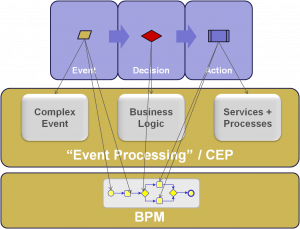 Thanks to James Taylor for pointing out an interesting blog post by EPTS member Jeff Adkins on a topic he calls the 4Ds – Detect, Derive, Decide and Do. Clearly this is very similar to the event-decision-action pattern mentioned here a few times, where event is neatly extended to detect (source or simple events) and derive (complex events). Good separation of concerns!
Thanks to James Taylor for pointing out an interesting blog post by EPTS member Jeff Adkins on a topic he calls the 4Ds – Detect, Derive, Decide and Do. Clearly this is very similar to the event-decision-action pattern mentioned here a few times, where event is neatly extended to detect (source or simple events) and derive (complex events). Good separation of concerns!
I fully concur with Jeff:
” I don’t believe this is limited to simply CEP or expert systems. This is the nature of a reactive system, which all computer systems in truth are. Even “proactive” systems are reacting to an understand of the world around us and a potential threat or opportunity (also known as situational awareness).”
The interesting thing here (and probably the topic for another post) is how this can be used to classify event processing technologies. For example, event stream processing (or ESP) is usually event edge (“detect” and some local “derive” in Jeff’s parlance). Event cloud processing is doing more of the same (“detect” and wider context “derive”), and often nudging into decisions (“decide”). Simple SOA technology usually fixes the events and hard-wires the decisions (“detect” and “decide” and “do”) although business decision engines (a.k.a. BREs) will sometimes be used to provide some agility on the “decide”. BPM is all about what to “do” of course with some fixed (hence human oriented) events and orchestrated decisions. Analytics technologies can be used to determine some of the “derive” pieces, albeit usually from a past data rather than a current event context. Etc Etc.





